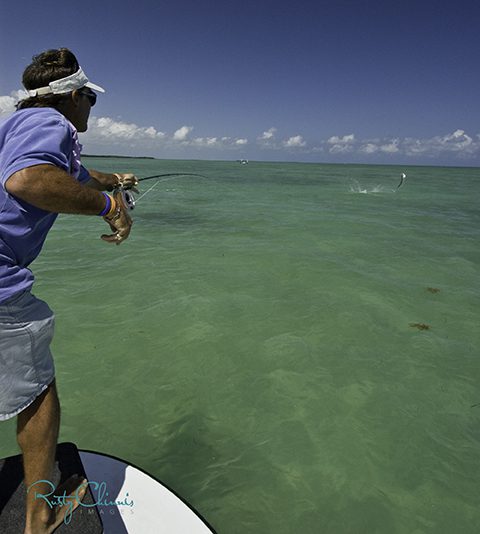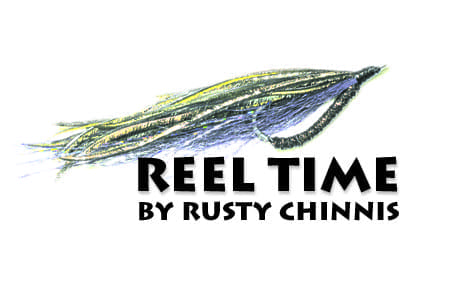Although tarpon can be one of the most exciting gamefish to engage, they are also one of the most demanding and exhausting. It’s not uncommon to hear stories of epic two-hour-plus battles, which are not good for the angler or the tarpon.
After experiencing the thrill of the catch, many anglers, not concerned with landing a tarpon again, prefer the hunt, the hook-up and the jumps that usually follow a hook set. They use light bite tippets which allow the tarpon to work through the leader with their abrasive mouths. The key to landing tarpon, especially on fly, is accuracy. While there are exceptions to every rule, the fly must be placed perfectly, move in a precise direction relative to the fish and be at the proper (fish’s) depth. Even when all these factors come together, there’s still about a 50% chance that the tarpon will reject the fly.
The go-to bait for spin anglers is a live crab. Small blue crabs can be purchased at bait shops and pass crabs can be dipped from the local passes on a falling tide. Other effective baits include pinfish, threadfin herring and pilchards. Artificial lures like the DOA Bait Buster and the 4- to 6-inch shrimp, jigs and even topwater plugs can be effective. Patience is a critical factor when fishing for tarpon, especially when fly fishing. One strategy used by fly anglers is to find the edge of a sand bar or other underwater feature that tarpon track, anchor in casting range and wait. Sometimes tarpon come at a steady rate, but just as often there are long periods of time when the only thing to look at is the water and the bottom. This really separates the great anglers from the good anglers. Others use their push pole to intercept their target. There are times when you need to move to a different area altogether, but knowing when and where is a skill that is developed, if never mastered.
Once set up, the angler must be able to make a 40- to 50-foot cast to a location the size of a dinner plate. The placement of the fly cannot be overemphasized because tarpon will seldom vary a foot or two from their path to eat a fly. Although there is always a rare exception, a fly must never travel in a path towards the intended target. A tarpon’s prey species wouldn’t survive long if it moved toward its aggressor and tarpon know it. If all this wasn’t demanding enough, once a tarpon decides to eat the fly, an angler’s mettle is really tested.

Conventional anglers usually look for rolling fish in the nearshore Gulf and motor well ahead of them to intercept their path. Trolling motors can be effective for following a school in deep water but will spook them in the shallows. One thing that all tarpon anglers should practice is courtesy. Often a boat has been working long and hard to get properly set up for a shot at an approaching school and a boat running up on the fish will spoil the day for everyone. Tarpon are not trout and attempting to raise the rod to set the hook is a cardinal mistake. Fortunately, once a tarpon decides to eat the fly there’s no need to make a lightning-fast hook set. The right set is called a “strip strike” which involves letting the line come tight and immediately setting the hook with a combination of the line hand and the rod. Conventional anglers should also have the patience to let the line come tight before attempting to hook the fish. After the initial hook set fly, the angler’s attention must go immediately to clearing the line. In most cases, the angler has been stripping in line when the fish bites and the hook is set. That line can easily foul on the angler, the rod or the reel. Once the line is on the reel, it’s time to set the hook with several more strip strikes, using the rod.
Conventional anglers often use circle hooks which don’t require a hook set. They just need to let the line come tight and enjoy the action. In any case, the tarpon cannot be aware of the angler on the other end until the hook is set. While it’s important to exert maximum pressure on the tarpon during the fight, anglers must yield on jumps. On the jump, the standard maneuver is to thrust the rod forward to relieve pressure on the line. This prevents the tarpon from breaking off if it lands on a taut line. This maneuver is known as “bowing to the king.”
If you’re looking for a good jump shot, here’s a great tip. When a tarpon makes any long run, motor close to it, applying only enough pressure to make sure the hook doesn’t dislodge. As soon as you are in place, frame the shot you want and then have the angler apply maximum pressure. Most times the tarpon will make a jump that’s close enough to the boat to get the angler and the fish in the shot. It’s not a sure thing, but when it works it can present an awesome photographic opportunity. Finally, don’t try and rush the tarpon when it gets near the end of the fight. Keep the pressure on but don’t clamp down and try to force the fish to the boat.
Good action can be found right through July for fly anglers, while the best month for conventional anglers is generally June. Tarpon fishing is a challenging endeavor, but it’s well worth the effort when you finally get that first-scale rattling jump. If you’re looking for fly tackle for tarpon, a local guide or timely advice seek out AMI Outfitters on Pine Street in Anna Maria. There’s no substitute for local knowledge!
































